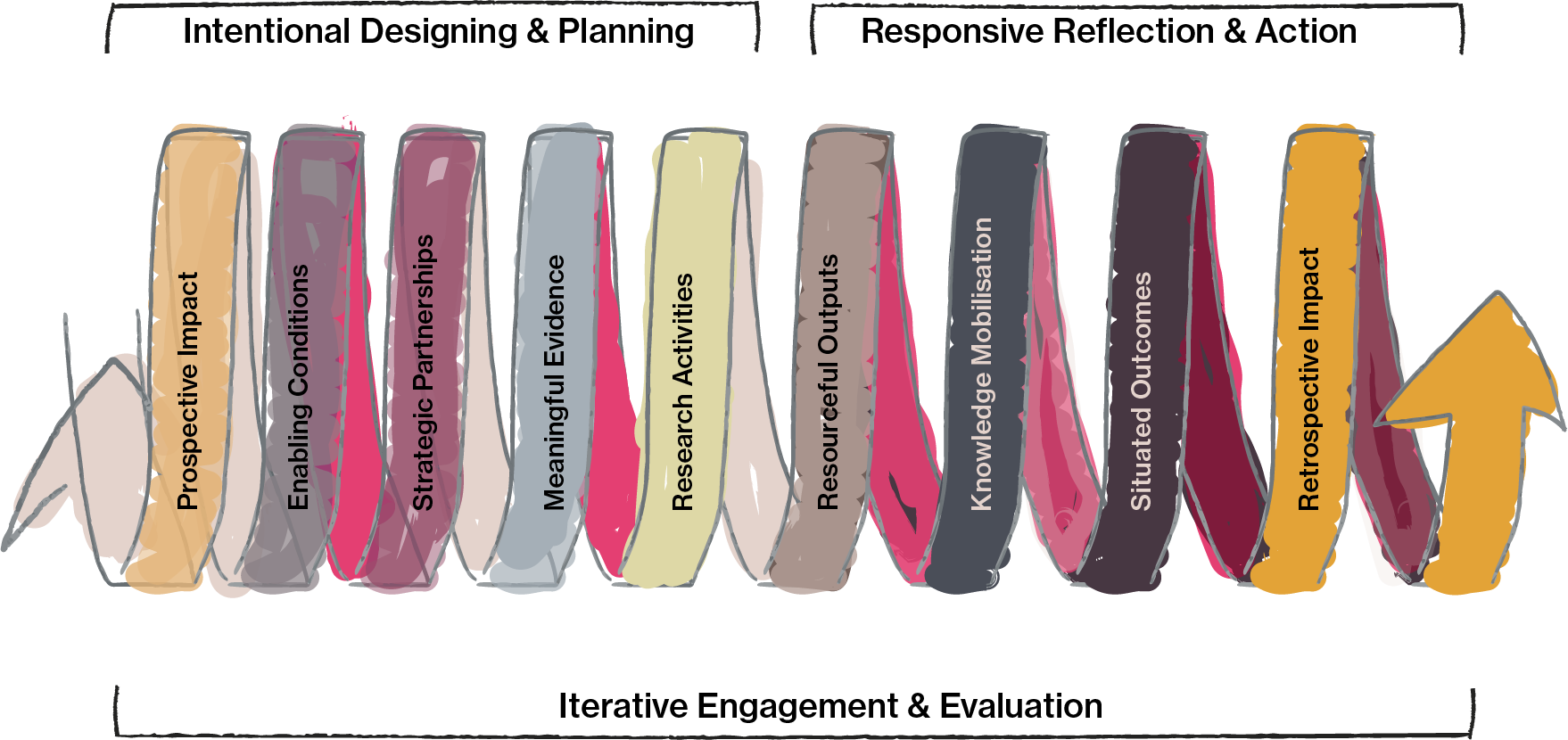If you're wondering how to responsibly integrate engagement activities or effectively mobilize your research, we are your people. If you respect different types of evidence and different ways of knowing, welcome. Let's wonder together.
If you are just looking for tools for evidencing impact, our belief that a shift to impact calls for a paradigmatic shift in practice might come across as a tad hyperbolic. That's okay too.
To sit with the implications for your research, read the shifting practice pane to see what unsettles or affirms your current approach. 20 mins.
To begin shifting your research practice, try some activities with colleagues. 2-6 hours.
To truly shift your practice, stop reading and start doing. Find opportunities to rehearse new ways of showing up, remember these principles, and learn from your mistakes. A lifetime.
Shifting Practice
We believe a turn to research impact calls for a shift in research practice. Yet changing how we do research is only simple in theory. In reality, changing how we practise is harder than learning a new skill, we are changing foundational principles.
The way we research is about more than our subject-matter expertise. Our research practice is a set of worldviews about how we see reality and how knowledge is constructed, the values we associate with methodological rigour and the beliefs we have about what evidence matters. Ultimately, the process of integrating new beliefs, habits, values and research activities leads to a transformed practice. The reflective, critical and rewarding yet hard labour of this kind of transformative change we call shiftwork.
The Shiftwork of Research Impact
We want the shiftwork of research impact to propose principles and strategies for working together differently. For this to happen we need new ways to collaborate so everyone on a project can do what they do well.
We recognise this shiftwork is as much an exercise in unlearning old habits as it is developing new skills. Learning how to work alongside partners with different values and ways of thinking takes time and humility. Reconfiguring the phases of your research takes practise and patience. Mobilising research outputs for new audiences calls for new skills and strategic thinking.

A Shift in Purpose
From New Knowledge ︎︎︎ Positive Social ChangeA shift in purpose comes with reframing the social contract of research from contributing to a field to positively making change in the world.
For some this shift is motivating because the contribution towards social change feels more tangible and necessary. It is a sense that the research matters. Others might feel disarmed by their lack of influence over the research once it leaves the academy and is led by partners. For some, the context determines the sense of purpose, with the researcher deferring to the community to tell them what is needed.


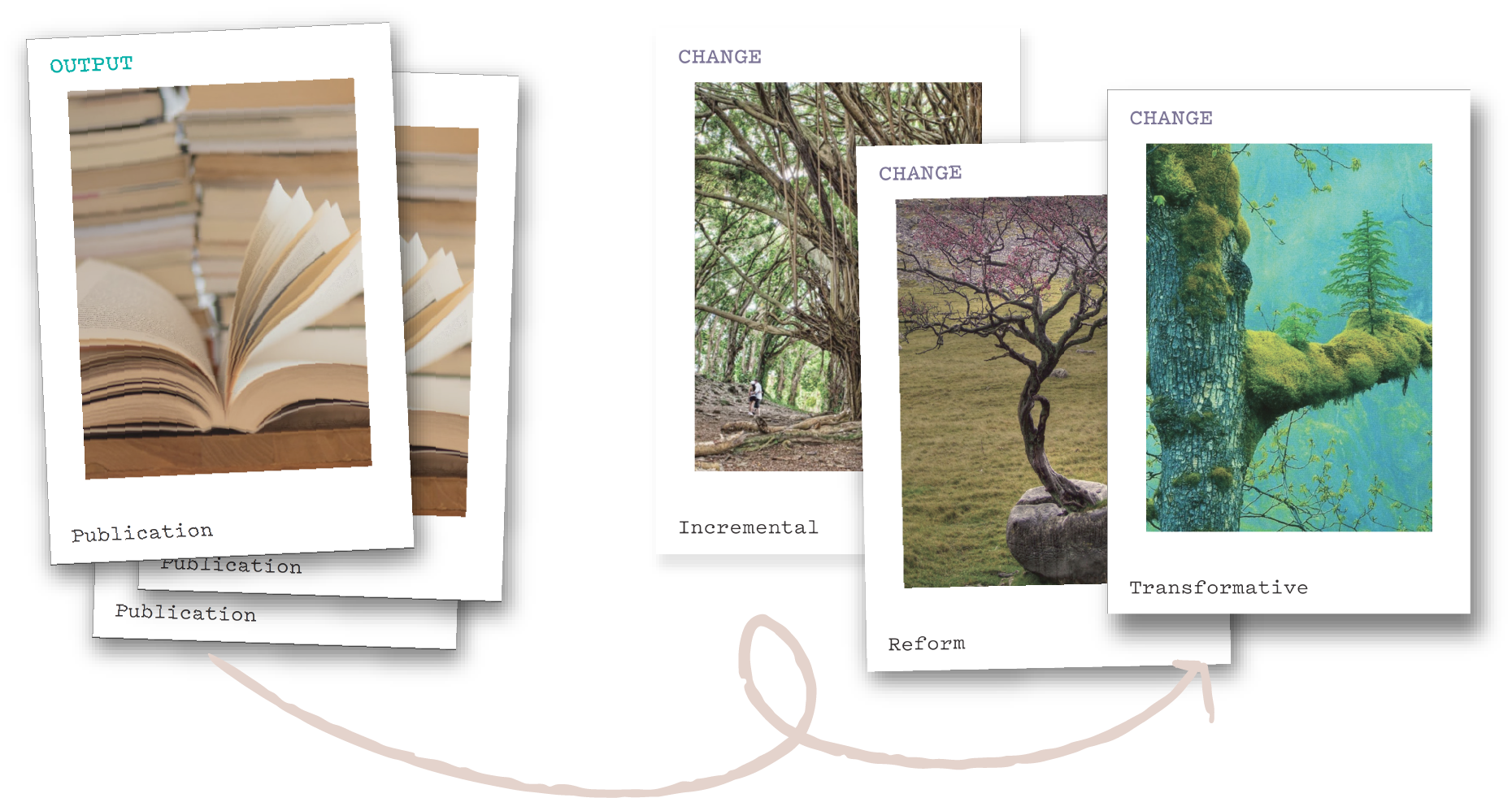
What would I have to change about how I begin my research if I am to identify pre-conditions for positive change?
What does it mean for research evaluation if the goal is not to gather data valued by a Q1 journal but to persuade influential
decision-makers?
What is
the contribution
I bring to an interdisciplinary collaboration: subject-matter expertise, a methodological way of working, or shared commitment to the context-space?
What partners and/or collaborators will round out the expertise I lack in this space?
Intrinsic Motivation
Why you are here matters. If you are concerned because you keep hearing that researchers need to evidence impact to get competitive grants and to please philanthropists then you might feel driven by external forces. Getting connected to what matters to you helps connect you to intrinsic motivations for caring about impact.
We are naturally inclined to be sceptical and frustrated when change is coming from above or from afar. However, if you take the time to identify why you are here for yourself you will have a clearer sense of purpose and be more motivated to make impact-positive changes in how you research. Our Finding Purpose activity can help you identify your core motivations as a researcher.

A Shift in Audience
From Academic Peers ︎︎︎ Project PartnersA shift from communicating with disciplinary peers to stakeholders signals a shift in audience. The question becomes which project partners can help translate your research outputs into the change the world needs.
Is your audience a funder, interdisciplinary colleagues, NGO partners, policy-makers or the people who will ultimately benefit from your research? Tough question. Most honest answer would be all of the above! Thinking about who the ‘next user’ of your research insights will be can help identify the audience or audiences for your output might be, even if these next users might be policy-makers, NGO leaders or healthworkers you might never meet.

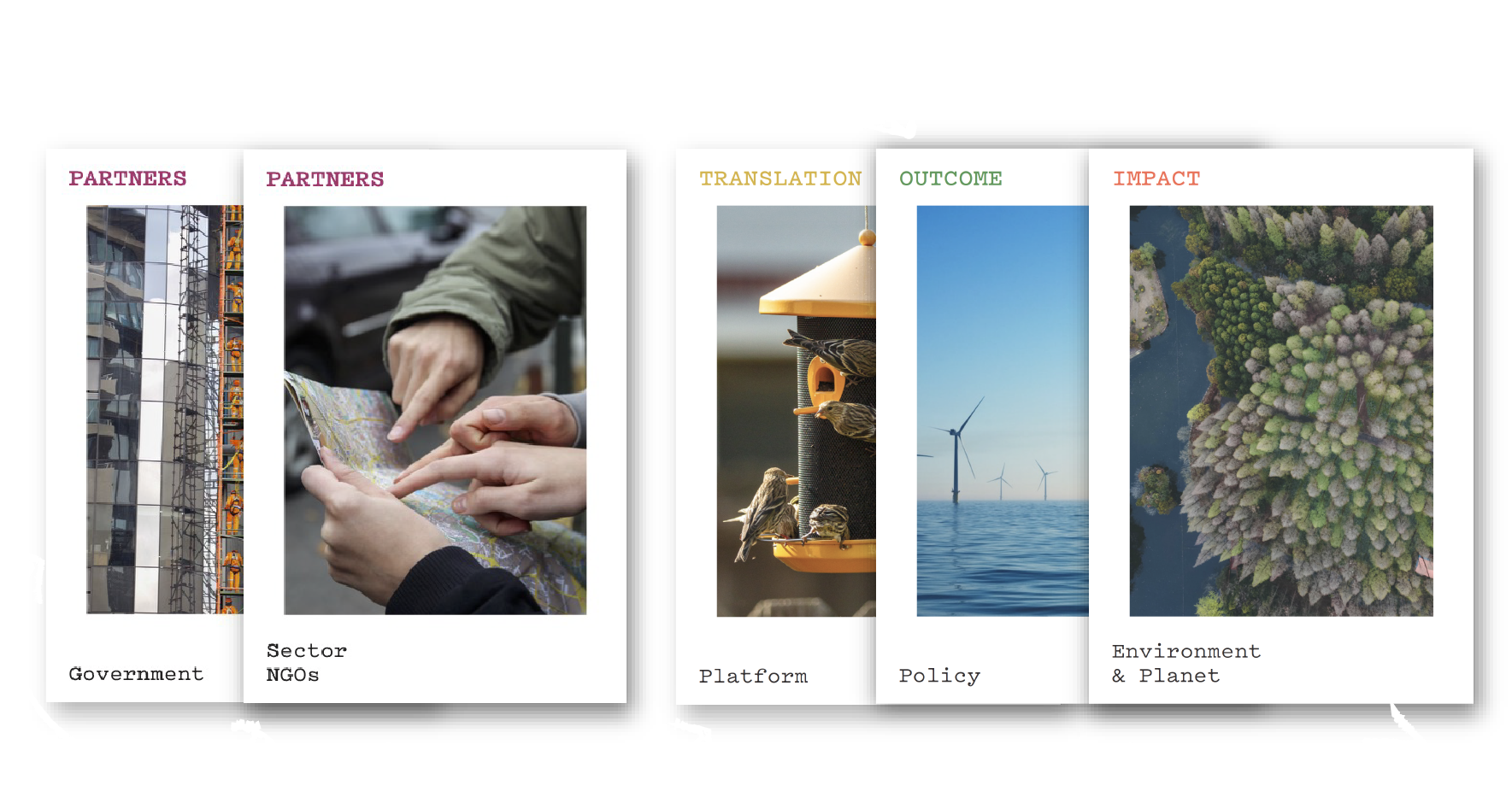
How to find
partners to work with beyond the next funding cycle?
When shall
I engage my audience
in co-defining the scope of the research?
What kind of knowledge and data will most
directly advance
the partners’ and funders’ missions?
What
evidence
will help partners make the case that the
theory of change
is grounded in strong assumptions?
Transformation takes Time
We know no one is going to become a different researcher after reading a website. Just as social transformation works in stages, shifting our research practice happens bit by bit, project by project.
Because shifting the way we practise takes practise, the pace of shiftwork is more complex than learning a new skill. Some shifts might be incremental and easy to adopt, like introducing more evaluation cycles. Other shifts might unsettle core values, like reimagining what rigour looks like in a community-led context. Yet others might reveal biases so internalised it might be a lifetime of unlearning, like respecting different types of evidence. The Tomorrow Party activity can help you time travel to a future where your research has already led to positive outcomes. In that future, you can embody and experience what making shifts both simple and profound might feel like and do.

A Shift in Activities
From Disseminating
︎︎︎
MobilisingThe move to engage the broad range of people invested in shared research amplifies the need for iterative engagement throughout all phases of the process. The pull toward engagement comes with respecting the expert-knowing different partners and community members bring to affirming relevance, checking assumptions, early piloting, identifying preliminary outcomes and sustaining successful implementation.
A shift in activities requires questioning what engagement activities and translation outputs will best serve the goal of the research insights being taken up and adopted by others. For these activities to be meaningful, you will need to decide when and where to invest your time and to whose expertise to defer to or delegate to.


How do we let go of an extractive research mindset and create engagement activities that are based in reciprocity and respect?
What parallel interdisciplinary projects can help present a comprehensive understanding of the situation that includes people’s lived experience, a systems perspective and big data trends?
How do we decide what research outputs will best serve the task of mobilising the knowledge to the right people?
What evaluation methods will help us see whether the translation artefacts are not just being distributed by actually enabling the conditions that will lead to change?
Values and Principles
The dynamic landscape of social impact calls for research practice that values context-specific knowing and pluralistic perspectives. Place-based work and engagement orientation further assert that things almost certainly will change, in small and in major ways, over the lifetime of a research project.
The way to manage this is not to shut down complexity or reduce the vitality of the research context to a rigid set of data points, analytical schema or pre-determined outcomes. Instead we can recognise our research contexts are never stable or fixed, but instead shifting always emerging. This means acknowledging that researching in place raises questions of power and exclusion, of ethics and authority, of values and positionality. To design for impact responsively we must take the time to understand the relationship between our research principles and our actions.

A Shift in Evidence
From Transferable Knowledge
︎︎︎
Integrated Evidence
Working in an applied context brings to the fore a shift in what counts as meaningful evidence. The chances of achieving sustained social change might be best achieved when working with transdisciplinary teams and multi-sectoral partners, which in turn leads to working with plural ontological and epistemic belief systems.
It can be a challenging (and rewarding) interdisciplinary collaboration when one researcher believes there is a single reality that can be measured and another believes reality is what we perceive and knowledge is always a matter of perspective. Add to that mix a local government partner whose pragmatism respects that reality is constantly being renegotiated, interpreted, and an Aboriginal elder who believes knowing, doing and being are mutually implicated, and memories of how to live sustainably on country are what matters. These kaleidoscopic perspectives of knowledge cannot be reduced to a debate about which research paradigm is right but more present a challenge in how to reconcile these divergent positivist, constructivist, pragmatist and Indigenous worldviews.

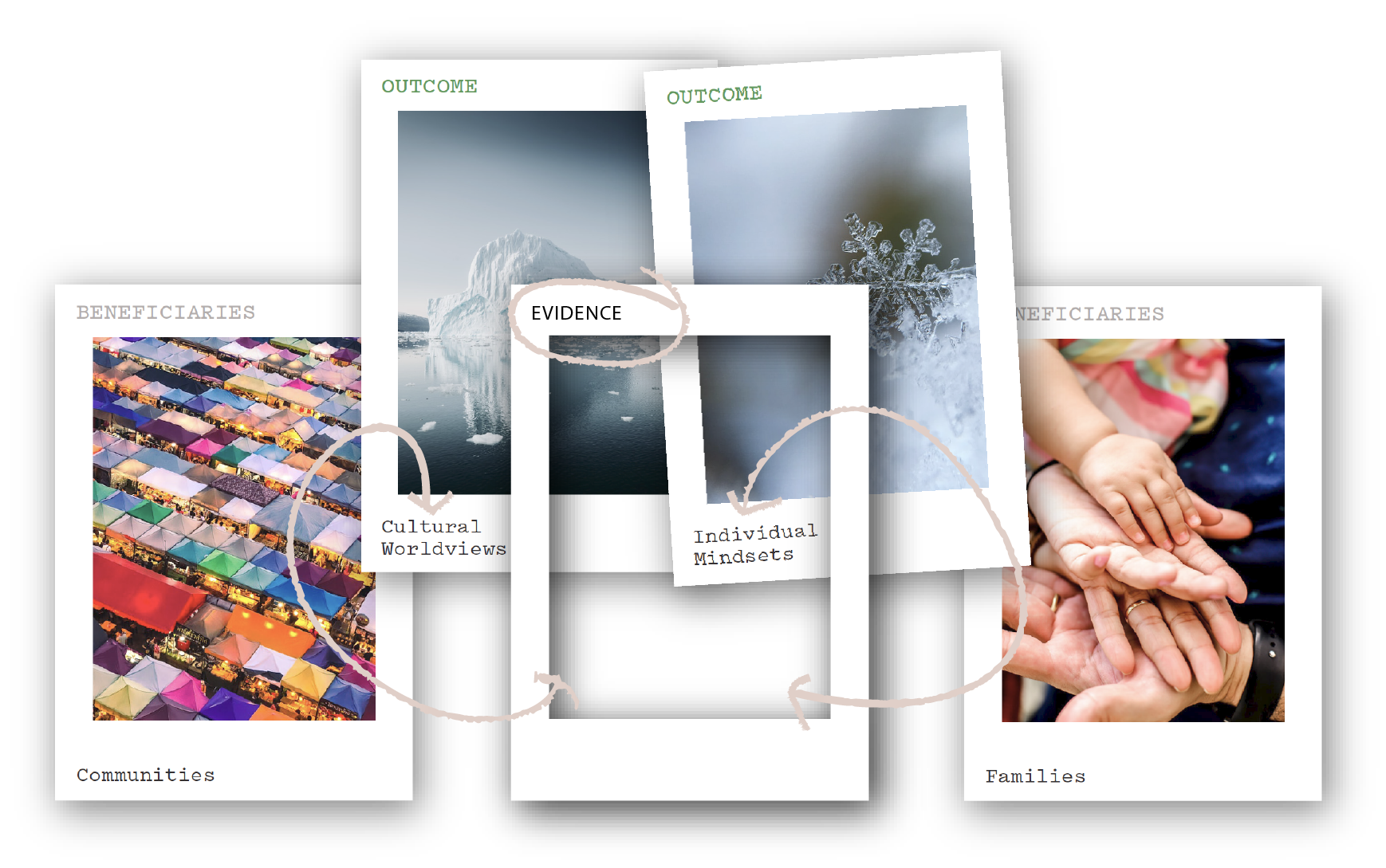
What forms of data and research output are important to gather given the people we have identified as next users of the research?
How might we integrate evidence from different sources in ways that propose a new kind of rigour?
Whose insights have authority in this context, who needs to be persuaded for change to come?
To what extent can we work together differently to make sense of disparate data sets, how might a new form of (co)-analysis that could emerge?
Unsettling Worldviews
The narrative around the social contract of academic research is not the only dominant narrative to be rewritten if we strive to unsettle patriarchal, racist, and capitalist systems. These radical require transforming social norms, cultural narratives and worldviews. Norms, narratives and worldviews are the hardest to nudge but these systemic changes also lead to the most seismic shifts.
Transformative systems change comes from the creative and critical act of making previously unimagined possibilities happen. To do this we need to envision new worlds. Impact is expansively reframed if aligned with Indigenous values of relationality, respect, responsibility and reciprocity in research. Indigenous knowledge systems and research impact recognise theory and praxis as co-generative, asking us to respect ways of knowing, doing and being as braided together. The In a World Where… activity is a place you can imagine such linked up worldviews and futures.

A Shift in Evaluation
From Accounting ︎︎︎ Accountability
When research extends beyond generating knowledge to seeding outcomes, a shift in how we evaluate the processes and outcomes of research becomes critical. Deciding what insights will inform the direction of the research requires open debate, active listening and intellectual respect within interdisciplinary teams. Just as blind peer review seeks to validate the rigour of scholarly inquiry, iterative evaluation seeks to continuously improve the integrity of research interventions as they connect with and make change in the world.
Retrospective impact assessments are good for giving accounts of positive outcomes. However, staged project evaluation offers a process of accountability that continuously checks assumptions and surfaces possibilities in context. This monitoring of real time changes as the research interventions unfold increases the chance of creating positive impact and flags early signs of unintended negative consequences.


What would it take to develop an evaluative mindset?
What, when, who and how will we intentionally monitor research assumptions?
Who can help co-create what the indicators for positive change look like in this specific context?
Who are the committed partners we can build relationships with, so we know change will continue to be evaluated long after our academic work is done?
Reframing Impact
Impact models and frameworks speak to the power of visual communication to expand and limit people’s perception of research impact. Here we iterate on versions of established impact diagrams to explore what each one highlights or marginalises.
The following diagrams chart a kaleidoscopic view of research impact by reframing dominant discussions and honouring the messiness of research in a social context. The emerging models recognise the always-in-flux, interconnected nature of any intervention in a social system. They help foreground values-based considerations and show how researching in complex living systems can be informed by context-specific ethnographic, participatory and creative inquiry.
Impact Results Chain
This is the conventional, decades-old logic model. You make an impact plan. You evaluate it. Simple, right?

If only. You can see how the linear logic of this model is akin to the hypothesis testing you might do in the controlled environment of a lab. Some assumptions are tested (are there any results?), but others (is this intervention even relevant?) are left unexamined.
This is how you end up with research that sends 10,000 toilets out into the world, only to find that the impact is negligible if people don’t want to use them.
Adapted Logic Model
This results chain adaptation sees the pathway to impact as collaborative. More colouring outside the boxes is called for. The caveat? Research does not always go to plan.


In this scenario, a local NGO could let you know toilets are not the solution. But how would you learn if the problem is a gap in awareness or infrastructure?
Impact in Context
Our conceptual map resists the linear logic of a phased approach. Instead, it reframes research impact by showing how research and engagement activities are interconnected. Nothing is simple, and that’s the point.
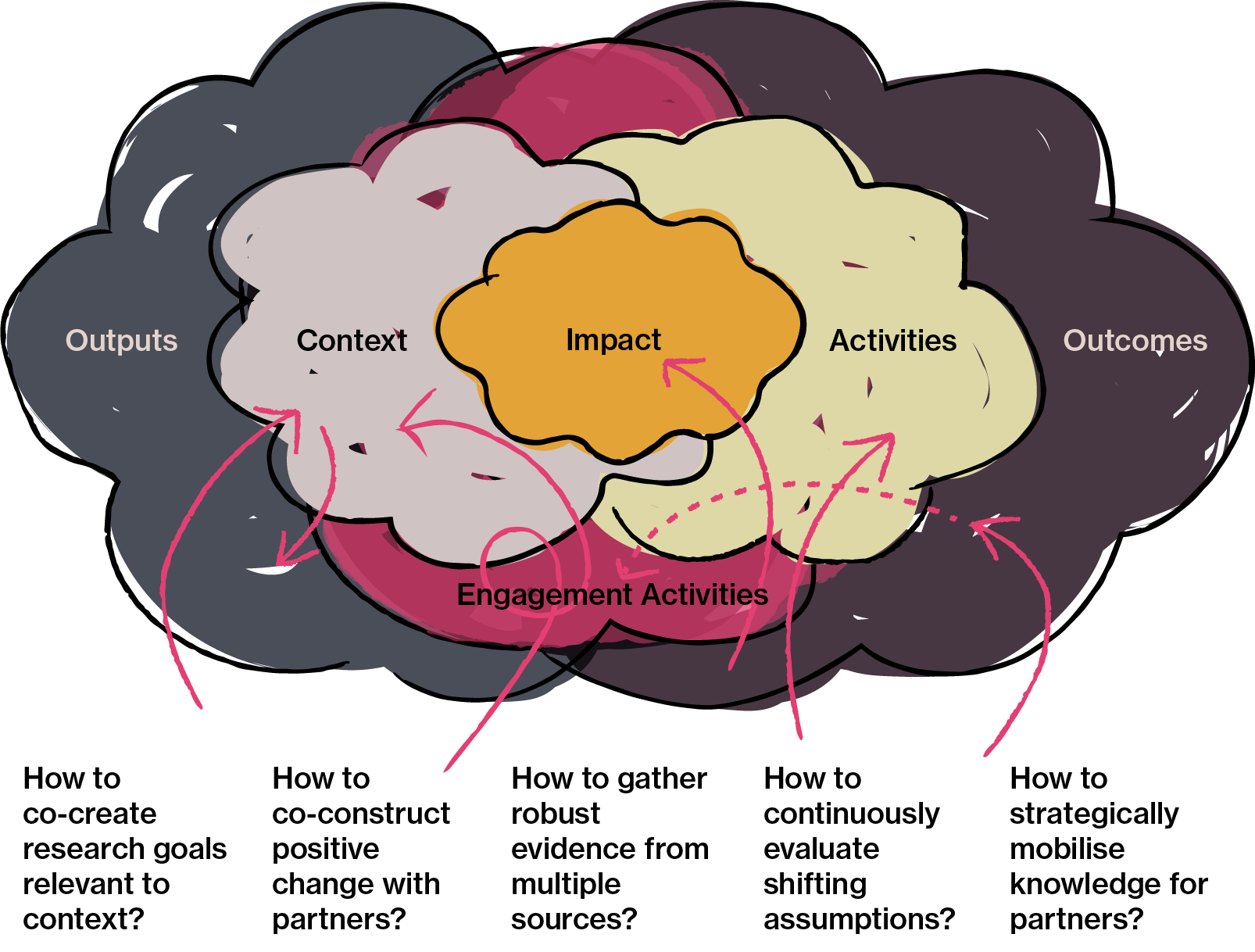

Every element of research is entangled and situated. Here a practice oriented toward research impact is continuously evaluating in context. Tethered to people and place, the layered activities begin not with questions of what the research needs in order to be impactful, but what the research situation asks of the team and their skills.
In this scenario, a trusted NGO could help facilitate a gathering to understand community cultural practices and specific ablution habits before prototyping solutions together. This can help to make sense of the most meaningful leverage point(s) in the system for improving health outcomes.
Impact by Design
This research practice diagram presents designing for impact as a looping process built for building and navigating entangled relationships. Pathways to impact are usually prospective plans or retrospective accounts. This loop resists seeing these orientations as connected rather than mutually exclusive.
The loop activates a responsible research practice that can negotiate complexity by working in multiple dimensions. Moving from a flat linear path into a spherical loop acknowledges the rigour required to work with the dynamic dimensions of a social context — to look within and out, to look up and down, to consider the past and future. The exterior loop proposes a way of doing the research, while the inner loop offers ways to position oneself and engage within the research context.
In this scenario, the researchers co-create with private/public sector partners and the community to understand local ablution habits and imagine together what positive change might look like years from now. This planning phase allows for context and diagnostic assumptions to be declared and revised, before the action phase investigates assumptions through interventions about what will lead to better health outcomes.
Impact Domains
There are many ways for researchers’ work to have an impact in the world. Social impact is only one domain within an integrated system of change.

Our emphasis on social impact does not dismiss the importance and the interconnectedness of discovery-based research or research focused on economic and sectoral impact. Engagement activities and research translation artefacts are integral to ensuring knowledge exchange between domains. Engagement with peak professional bodies can drive more sustained societal change, just as the translation tool that mobilises knowledge from a social impact initiative becomes future data for a scholarly paper. A virtuous cycle of impact becomes possible.
Social Systems
When research leaves the academy, new challenges and opportunities surface as the hunches, theoretical models, and abstract data come into contact with dynamic systems.
